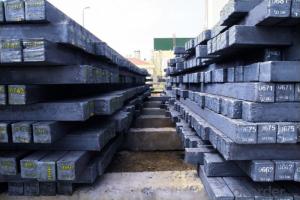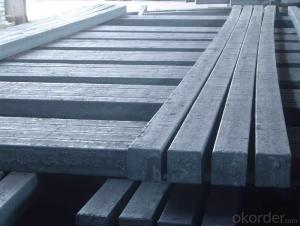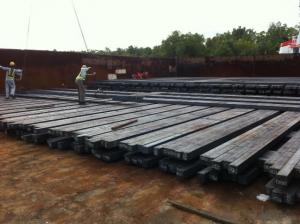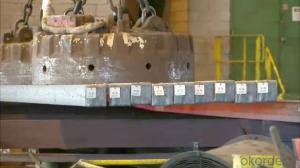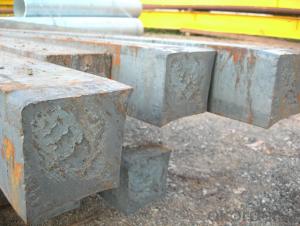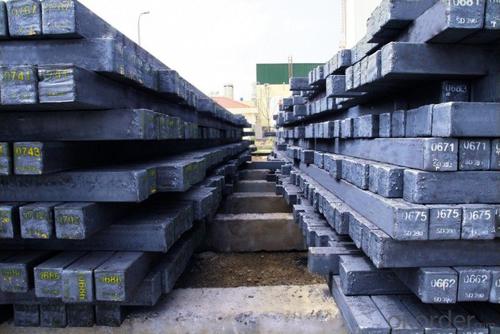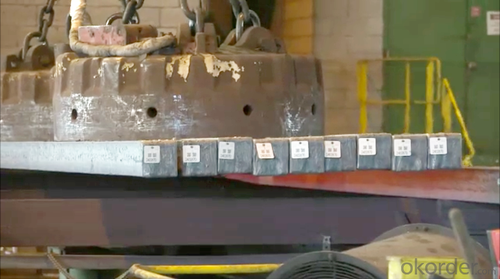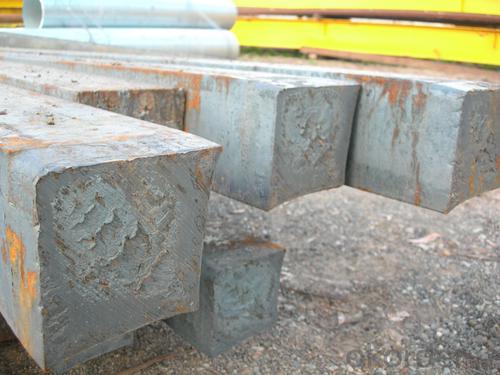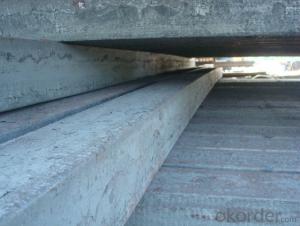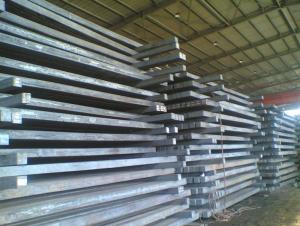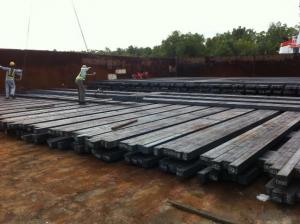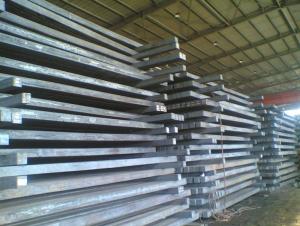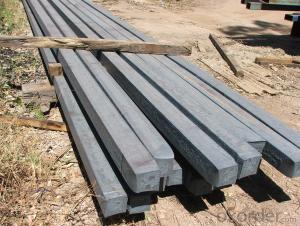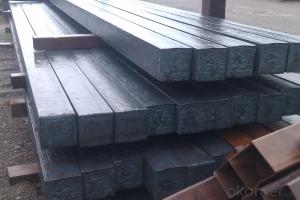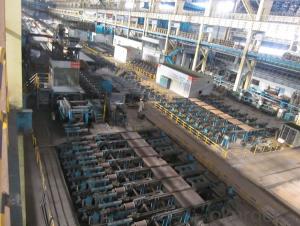Prime quality square alloy steel billet 165mm Q235
- Loading Port:
- Tianjin
- Payment Terms:
- TT OR LC
- Min Order Qty:
- 100 m.t.
- Supply Capability:
- 10000 m.t./month
OKorder Service Pledge
OKorder Financial Service
You Might Also Like
Structure of Prime quality square alloy steel billet 165mm Q235
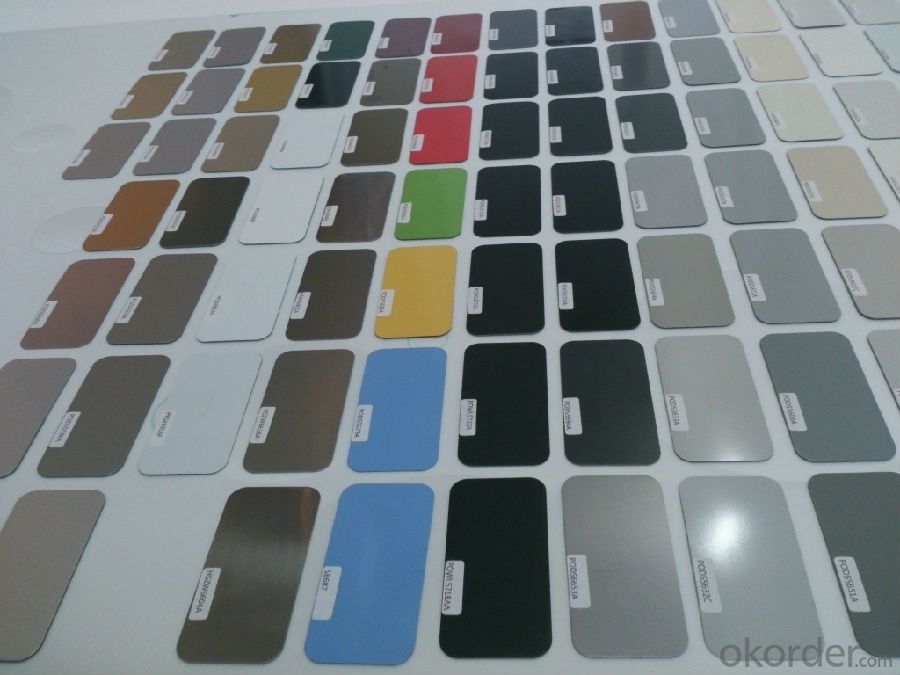
Description of Prime quality square alloy steel billet 165mm Q235
1. Prepainted steel coil is coated with organic layer, which provides higher anti-corrosion property and a longer lifespan than that of galvanized or galvalume steel sheets.
2. The base metals for prepainted steel coil consist of cold rolled, HDGI Steel, electro-galvanized and hot-dip alu-zinc coated steel. The finish coats of prepainted steel coil can be classified into groups as follows: polyester, silicon modified polyesters, polyvinylidene fluoride, high-durability polyester, etc.
3. The production process has evolved from one-coating-and-one-baking to double-coating-and-double-baking, and even three-coating-and-three-baking.
4. The color of the prepainted steel coil has a very wide selection, like orange, cream-colored, dark sky blue, sea blue, bright red, brick red, ivory white, porcelain blue, etc.
5. The prepainted steel coils can also be classified into groups by their surface textures, namely regular prepainted sheets, embossed sheets and printed sheets.

Main Feature of Prime quality square alloy steel billet 165mm Q235
Uncoated CR steel sheet
With the features of in line with the international highest standards in demension and shape, excellent surface finish and properties, the products are mainly used in home appliance and automobile industries.
Galvanized steel sheet(include HDG and EG)
With the features of good corrosion resistance, the products are mainly used in automobile, home appliance, electronics, building and machinery manufacture industries, etc.
Precoated steel sheet
With the features of enviromental protection and good processablility, long lasting surface durability, rich in colors, the products are maily used in building, home appliance and furniture industries, etc.
Applications of Prime quality square alloy steel billet 165mm Q235
Construction
Manufacture anticorrosion, industrial and civil architecture roof boarding, roof grille
Light industries
Home appliance's case, civil chimney, kitchen utensils
Auto industry
Corrosion resistant parts of cars
Agriculture
Food storage, meat and aquatic products' freezing and processing equipment
Commerce
Equipments to store and transport materials, and packing implements

Specifications of Prime quality square alloy steel billet 165mm Q235
Product | Prime quality square alloy steel billet 165mm Q235 |
Material Grade | SGCC / SGCH / DX51D+AZ, etc |
Thickness | 0.6-3.0mm |
Width | 500-1500mm |
Tolerance | Thickness: +/-0.02mm , Width:+/-2mm |
Zinc-coating | Z30-150g/m2 |
Technique | Raw material: Hot rolled steel coil --> Cold rolled_>hot dipped galvalume |
Surface | Dried, Chromated, Unoiled |
Spangle | Regular spangle , small spangle, zero spangle |
ID | 508MM 610MM |
Coil weight | 1-25MT |
Export package | Cardboard inner sleeves, Waterproof paper, galvanized steel covered and steel strip packed |
FAQ of Prime quality square alloy steel billet 165mm Q235
We have organized several common questions for our clients,may help you sincerely:
1. How Can I Visit There?
Our company is located in Tianjin City, China, near Beijing. You can fly to Tianjin Airport Directly. All our clients, from home or aboard, are warmly welcome to visit us!
2. How Can I Get Some Sample?
We are honored to offer you sample.
3. Why choose CNBM?
Our delivery time about 15-20days for standard sizes, if you have other requirements like hardness, quanity and width ,it is about 20-40days. But don't worry we also try our best for the delivery time ,because time longer and our cost is higher.
- Q: If the casting speed is not steady, what will happen to the billet?
- Secondly, the speed of cutting is unstable, and the cut rate will be reduced.
- Q: How are steel billets used in the production of structural steel?
- Structural steel production relies heavily on steel billets, which are indispensable for the manufacturing process. These semi-finished steel products serve as the initial material, from which the transformation begins. To initiate the production of structural steel, scrap steel is melted in a high-temperature furnace. Once the steel reaches its liquid state, it is poured into molds that give it a solid, rectangular shape with a uniform cross-section. After the billets solidify, they are transported to a rolling mill. In this facility, the billets are reheated to a specific temperature and passed through a series of rollers. With each pass, the billets progressively undergo size and shape reduction. This crucial step, known as hot rolling, refines the mechanical properties of the steel. The hot-rolled billets then proceed to various techniques, including forging, extrusion, or casting, to achieve specific shapes and sizes required for structural applications. These techniques enable the transformation of the billets into beams, columns, plates, or other components necessary for construction projects. Once the desired shape is attained, the structural steel undergoes several treatments to enhance its strength, durability, and resistance to corrosion. Heat treatment, surface coating, and additional alloying elements may be employed for this purpose. Ultimately, the finished structural steel products find application in a wide range of projects, including the construction of buildings, bridges, and infrastructure. The consistent size and shape of the steel billets ensure that the resulting components possess the necessary strength, stability, and structural integrity to withstand the loads and stresses they will encounter. In conclusion, the importance of steel billets in structural steel production cannot be overstated. They serve as the fundamental material that undergoes various processes to achieve the desired shapes and sizes required for construction. The quality and uniformity of the billets are paramount in ensuring the strength and durability of the final structural steel products.
- Q: How are steel billets used in the manufacturing of storage tanks?
- Steel billets serve as the primary raw material in the manufacturing of storage tanks. These semi-finished metal forms act as the starting point for producing steel plates or sheets, which are later used to construct the tank walls and base. Once obtained, the steel billets undergo heating and are then passed through a series of rollers to gradually shape them into the desired form. This process, known as hot rolling, is essential for creating the necessary thickness and dimensions required for the storage tank. Following the hot rolling process, the steel billets undergo further processing to eliminate any surface impurities or imperfections using a technique called descaling. This step guarantees the quality and durability of the final tank structure. Next, the steel billets are cut into smaller pieces, referred to as plates or sheets, which are then shaped and welded together to form the tank shell. These plates are meticulously cut and shaped according to specific engineering drawings and designs, ensuring that the tank meets the required specifications for strength, capacity, and structural integrity. Apart from the tank shell, steel billets are also used in manufacturing the tank's base or floor. The billets are processed and formed into the required shape, which is then welded or bolted to the tank shell to create a solid foundation for the storage tank. In conclusion, steel billets play a crucial role in the manufacturing of storage tanks by providing the necessary raw material for building the tank structure. Through various processes, the billets are transformed into steel plates and sheets, which are then shaped into the tank shell and base, ensuring the tank's strength and durability.
- Q: What is the role of steel billets in the production of automotive components?
- Steel billets play a crucial role in the production of automotive components. These billets are semi-finished metal products that serve as the raw material for various parts used in the automotive industry. Firstly, steel billets are used to manufacture engine components such as crankshafts, camshafts, and connecting rods. These are vital parts that contribute to the smooth functioning of the engine. The strong and durable properties of steel make it an ideal material for these components, ensuring they can withstand the high temperatures and pressures within the engine. Secondly, steel billets are used to produce chassis and suspension components. These include parts like control arms, steering knuckles, and axle shafts, which are responsible for the vehicle's stability, maneuverability, and overall performance. Steel's high strength-to-weight ratio and excellent fatigue resistance make it suitable for these safety-critical components. Furthermore, steel billets are utilized in the production of transmission and drivetrain components. These include gears, shafts, and clutch plates, which are essential for transmitting power from the engine to the wheels. Steel's toughness, wear resistance, and ability to handle high torque loads make it an ideal material for these parts, ensuring their durability and reliability. Additionally, steel billets are used in the manufacture of body and interior components. These can include door hinges, brackets, seat frames, and various structural parts. Steel's versatility, formability, and corrosion resistance make it an excellent choice for these components, providing strength and protection to the vehicle's occupants. Overall, steel billets form the foundation for the production of a wide range of automotive components. They provide the necessary strength, durability, and reliability required for critical parts in engines, chassis, transmission systems, and body structures. Without steel billets, the automotive industry would struggle to produce high-quality and safe vehicles.
- Q: How do steel billets contribute to sustainable construction?
- Steel billets play a crucial role in sustainable construction through various means: 1. Energy efficiency: By utilizing electric arc furnaces, steel billets require less energy than traditional manufacturing methods. This leads to decreased greenhouse gas emissions and a reduced carbon footprint. 2. Recyclability: Steel billets can be recycled multiple times without losing their mechanical properties, making steel one of the most recycled materials worldwide. This conserves natural resources, reduces waste disposal, and lessens the need for new steel production. 3. Strength and durability: With their exceptional strength and durability, steel billets are an excellent choice for sustainable construction. Their structural integrity ensures long-lasting buildings, minimizing the need for frequent repairs or replacements and extending the lifespan of structures. 4. Versatility: Steel billets can be shaped and formed into various structural components, allowing for flexible design and construction. This adaptability enables the construction of sustainable buildings that can easily accommodate changing requirements, reducing the necessity for new construction. 5. Resilience to natural disasters: Steel billets exhibit outstanding resistance to seismic forces, hurricanes, and other natural disasters. This makes them ideal for constructing buildings in disaster-prone regions, thereby enhancing the safety and resilience of the built environment. 6. Reduced construction time: The prefabricated nature of steel billets enables faster construction, minimizing disruption to the environment and local communities. Additionally, prefabricated steel components can be easily dismantled and reused, further enhancing sustainability. In conclusion, steel billets contribute significantly to sustainable construction by reducing energy consumption, offering recyclability, providing strength and durability, allowing for design versatility, resisting natural disasters, and reducing construction time. By incorporating steel billets into construction projects, we can create environmentally-friendly and long-lasting structures that promote sustainability in the built environment.
- Q: How do steel billets contribute to the manufacturing of automotive components?
- Steel billets play a crucial role in the manufacturing of automotive components. These billets, which are semi-finished metal pieces, serve as the starting material for the production of various automotive parts. One of the main ways steel billets contribute to automotive component manufacturing is through the process of forging. Forging involves shaping the metal billets under high pressure and temperature, typically using a hammer or a press, to create the desired automotive parts. This process helps in enhancing the strength, durability, and reliability of the components, making them suitable for the demanding conditions of the automotive industry. Steel billets are also used in the production of engine components such as crankshafts, connecting rods, and piston rods. These parts require high strength and resistance to wear and tear, which are achieved by starting with high-quality steel billets. By using steel billets as the raw material, automotive manufacturers can ensure that the resulting components have the necessary mechanical properties to withstand the stresses and forces experienced by the engine during operation. Furthermore, steel billets are employed in the manufacturing of suspension components, such as control arms and stabilizer bars. These components are responsible for maintaining the stability, handling, and comfort of the vehicle. Using steel billets in their production ensures that the suspension components can withstand the heavy loads and impacts encountered on the road, providing a smooth and safe driving experience. Additionally, steel billets contribute to the manufacturing of safety-related automotive components. For instance, they are used in the production of structural components like chassis frames and body reinforcements. These components are essential for protecting the occupants in the event of a collision or impact, and steel billets provide the necessary strength and rigidity to ensure their effectiveness. In conclusion, steel billets are a vital element in the manufacturing of automotive components. They enable the production of strong, durable, and reliable parts, ensuring the overall performance, safety, and longevity of vehicles. By starting with high-quality steel billets, automotive manufacturers can meet the demanding requirements of the industry and deliver high-performance vehicles to consumers.
- Q: What are the different surface treatments for steel billets?
- There are several different surface treatments that can be applied to steel billets to enhance their performance and protect them from corrosion. One common surface treatment is hot-dip galvanizing, where the steel billets are dipped into a bath of molten zinc. This creates a protective coating of zinc on the surface of the billets, which acts as a barrier against moisture and other corrosive elements. Another option is electroplating, where a thin layer of metal, such as chromium or nickel, is deposited onto the surface of the steel billets using an electric current. This not only provides corrosion resistance but can also improve the appearance of the billets. A third surface treatment method is painting or powder coating. This involves applying a layer of paint or dry powder onto the surface of the billets. The paint or powder forms a protective barrier that prevents moisture and other corrosive substances from reaching the steel. Additionally, shot blasting or sandblasting can be used as a surface treatment for steel billets. This involves propelling abrasive particles at high speeds onto the surface of the billets to remove any impurities or scale, leaving a clean and smooth finish. Lastly, there are also chemical treatments available for steel billets. One example is phosphating, where the steel is immersed in a phosphoric acid solution, resulting in the formation of a protective phosphate coating on the surface. This coating improves corrosion resistance and promotes paint adhesion. Overall, the choice of surface treatment for steel billets depends on the specific requirements of the application and the desired level of protection against corrosion and other environmental factors.
- Q: What are the different heat treatment processes for steel billets?
- The different heat treatment processes for steel billets include annealing, normalizing, quenching, tempering, and stress relieving.
- Q: What are the different surface defects that can occur in steel billets?
- Steel billets can suffer from a variety of surface defects. Among the most common are: 1. Scale: During heating, a rough, flaky oxide layer known as scale can form on the billet's surface. This coating can negatively impact the final product's quality. 2. Cracks: Thermal stress, improper handling, or excessive cooling can cause cracks to appear on the billet's surface. These cracks can be either longitudinal or transverse and compromise the overall structural integrity of the billet. 3. Decarburization: High temperatures or chemical reactions can lead to the reduction of carbon content at the steel's surface, a process known as decarburization. This weakens the outer layer, affecting the billet's mechanical properties. 4. Pits: Corrosion, inadequate cleaning, or chemical reactions can result in small depressions or cavities on the billet's surface, known as pits. Pits can reduce strength and create localized stress concentrations. 5. Surface roughness: Improper handling, insufficient machining, or poor surface finishing can leave steel billets with uneven or rough surfaces. This can impact the final product's appearance and performance. 6. Inclusions: Non-metallic materials become trapped in the steel during manufacturing, forming inclusions. They can appear as dark spots, streaks, or irregular shapes on the billet's surface. Inclusions weaken the steel and decrease its ductility. 7. Surface contamination: Handling or storage can introduce foreign materials like dirt, oil, or grease to steel billets, leading to surface defects, corrosion, or compromised quality. Detecting and addressing these surface defects early in the manufacturing process is crucial to ensure high-quality steel billets. Various inspection techniques, including visual examination, ultrasonic testing, and magnetic particle inspection, can be used to identify and mitigate these defects.
- Q: How do steel billets contribute to the overall safety of a structure?
- Steel billets play a significant role in contributing to the overall safety of a structure in several ways. Firstly, steel billets serve as the raw material for manufacturing steel bars, beams, columns, and other structural components. These components are widely used in construction due to their high strength and durability. By using steel billets as the starting material, the resulting steel products exhibit excellent load-bearing capacity, which enhances the structural integrity of the building. Moreover, steel billets undergo a rigorous manufacturing process that includes various quality control checks. These checks ensure that the billets possess consistent and reliable mechanical properties, such as high tensile strength and impact resistance. As a result, when these billets are used in the construction of a structure, they contribute to its overall safety by providing a reliable and robust framework that can withstand external forces, such as wind, earthquakes, or heavy loads. Additionally, steel billets are often produced using advanced metallurgical techniques, such as controlled cooling or heat treatment, to achieve specific properties required for structural applications. These processes help in improving the microstructure of the steel, reducing internal defects, and enhancing its resistance to corrosion, fatigue, and other forms of degradation. This, in turn, increases the lifespan of the structure and minimizes the risk of structural failure, thus ensuring the safety of the occupants. Furthermore, steel billets can be manufactured with precise dimensions and tolerances, allowing for accurate and efficient construction. This precision in fabrication ensures that structural components fit together seamlessly, reducing the likelihood of gaps, misalignments, or weak points that could compromise the safety of the structure. Lastly, steel billets are highly recyclable, making them an environmentally friendly choice for construction. By opting for steel billets, the construction industry can reduce its carbon footprint and contribute to sustainable development. This focus on sustainability aligns with the overall safety of a structure, as a sustainable approach ensures the long-term stability and resilience of the built environment. In conclusion, steel billets contribute to the overall safety of a structure by providing high-strength, durable, and reliable materials for construction. Their consistent mechanical properties, resistance to external forces, improved microstructure, and precise fabrication ensure a strong and secure framework. Moreover, their recyclability promotes sustainability, further enhancing the long-term safety and integrity of the structure.
Send your message to us
Prime quality square alloy steel billet 165mm Q235
- Loading Port:
- Tianjin
- Payment Terms:
- TT OR LC
- Min Order Qty:
- 100 m.t.
- Supply Capability:
- 10000 m.t./month
OKorder Service Pledge
OKorder Financial Service
Similar products
Hot products
Hot Searches
Related keywords
